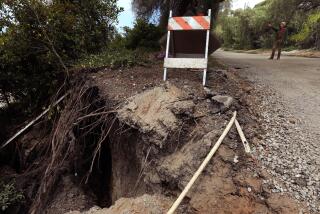Budget Cuts, Enrollment Gains Create Campus Jams : Education: Slashes in state funding force some community colleges to cut hundreds of classes. In the future, students may be turned away.
As the spring semester begins, financially strapped community colleges in the San Fernando, Santa Clarita and Antelope valleys are struggling with growing enrollments and fewer classes, resulting in long waiting lists for many courses.
State-imposed budget cuts have forced two colleges to cut hundreds of classes, while funding shortages have caused other campuses to put expansion plans on hold.
Some students who were unable to enroll in classes required for transfer to four-year schools may have to remain at community colleges longer.
Moreover, with even leaner times ahead, some community colleges may have to turn away students in the future, educators said.
“We’re growing and we’re not getting paid for some of the students,” said Gary Olmstead, dean of business services at College of the Canyons. “We’re a child of the state in that it funds us.”
Both Pierce and Valley colleges were told to slash $1 million from their budgets last summer after the Los Angeles Community College District learned it would receive only $363 million from the state for 1990-91, about $8 million less than expected.
College of the Canyons, the only campus in the Santa Clarita Community College District, was not as harshly affected.
But even that college cut classes this semester rather than expand offerings to keep up with the population growth in Santa Clarita Valley.
With even less money for education in the proposed state budget for next year, community college administrators don’t expect their financial situations to improve in the near future.
“It’s looking pretty bleak,” one educator said.
So far, colleges have been able to cope with declining budgets.
But as Antelope Valley College spokesman Steve Sanderfer put it: “With a tight state budget, things could change.”
Hardest hit this semester were Pierce and Valley, which began spring courses last week.
Pierce had as many as 13,000 names on class waiting lists, frustrating students.
At Valley, which also had long waiting lists, many classrooms were crowded as teachers accepted more students than usual into their courses.
College of the Canyons canceled 37 classes after the spring schedule was published.
Many students stood in line for several hours during registration to rearrange their schedules.
Administrators there said they also are considering canceling summer school.
Glendale and Antelope Valley colleges have not cut classes, but had waiting lists for some courses because of rapidly growing enrollments.
Both were running out of classroom space and administrators feared future cuts might jeopardize building programs planned to ease crowding.
“We’re just running out of room,” Glendale College spokeswoman Merry Shelburne said. “Our enrollment is spiraling.”
At Pierce and Valley, English and mathematics classes were most affected by the budget crunch.
William Norlund, Pierce’s vice president of academic affairs, said the college cut 100 of its planned 2,000 classes in the fall and scheduled 200 fewer classes for the spring semester.
For the first time in history, Norlund said, the college allowed waiting lists of unlimited numbers of students in an attempt to assess the class demands.
Classes such as freshman English, a required course for students planning to transfer to four-year schools, had waiting lists up to 140.
“We found some additional funds and opened another 30 classes, but still there are problems,” Norlund said. “Many students are not getting into the classes they want or need.”
He said there are three requests for every seat available in the 17 current English classes.
“I could open another 30 without batting an eye, if I had the money,” Norlund said. “But we’re down to the bare bones.”
Generally, only the students who preregistered for courses early last winter received their choice of classes.
Most of those who waited until general registration periods found themselves on waiting lists for popular classes.
The college hopes to schedule summer school classes in English, math and other subjects to accommodate “as many students as we can,” Norlund said.
He said he is concerned that the college’s enrollment will drop if students cannot enroll in the courses they want or need, resulting in even less funding from the state.
Canceling classes is almost self-destructive for state-supported colleges, because funding is based on enrollment during the previous year, he pointed out.
“We are packed and we could expand,” Phil Stein, dean of admissions and records, said. “In the past, we could have scheduled more classes, but now we can’t. I even teach one anthropology class that’s full.”
Sam Muhayimana, student body president at Pierce, is worried that the class shortage may result in some students spending another year at the school because they will not have the required courses to transfer to a four-year college or university.
Muhayimana criticized the waiting lists, saying they offer false hope to students. “Why not just tell us the class is closed?”
At Valley, 197 classes were dropped from the fall semester schedule. This semester, 130 were cut.
In the past, the college was able to add classes when enrollment was high. But this year that cannot be done, said Mary Spangler, dean of admissions.
“The consequence is that students on standby lists won’t be accommodated,” said Tyree Wieder, the college’s vice president of academic affairs.
Teachers have helped out by accepting as many as 45 students in their classes, resulting in some classroom crowding, Wieder said.
Still, she said, “I have waiting lists for practically every class we offer.”
At Glendale College, Shelburne said the college waiting lists are the result of enrollment increases of 4% to 5% each year.
“We certainly haven’t had to cut any classes,” she said. “Our budget has been pretty stable.”
However, Shelburne said Glendale administrators are concerned that classroom expansion plans may not materialize if the state cuts more funds.
Antelope Valley College’s Sanderfer said spring enrollment exceeded fall enrollment for the first time in history. “This sends us a signal that in the fall we’re going to be in a crunch.”
Both Antelope Valley and College of the Canyons have accepted more students than the state pays them for.
College of the Canyons used $270,000 in reserve funds to keep classes intact in the fall.
“We could have taken money out again for spring, 1991,” said James Walters, the school’s assistant superintendent-vice president, last month when the college canceled 37 classes. “But you have to reach a point where you say that’s enough.”
The state cuts had little effect at tiny Mission College, also one of the Los Angeles district’s nine campuses. “It’s so small, there isn’t anywhere to cut,” a spokeswoman said.
Mission College--at 6,000 students the smallest of the colleges--is building a permanent campus in Sylmar to replace the storefronts it has rented in San Fernando for years.
But spokeswoman Ina Geller said that college officials already are trying to extract a commitment from the state to expand the college.
Even if the main building now under construction opens on schedule later this year, Geller said the college will still need more space to house its growing enrollment.
More to Read
Sign up for Essential California
The most important California stories and recommendations in your inbox every morning.
You may occasionally receive promotional content from the Los Angeles Times.






